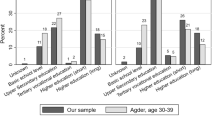Abstract
The emotional and behavioural problems of 7- to 15-year-old Finnish children and adolescents (n = 735) were assessed in a community population by a brief screening instrument, the Strengths and Difficulties Questionnaire (SDQ). The parent-, teacher- and self-reports of the SDQ were obtained. The results show that for the total scores, the inter-rater agreement between the pairs of reports was 0.38–0.44. The internal consistency in all three questionnaires was 0.71. Functioning above the 90th percentile of the SDQ total difficulties scores in parent-, teacher- and self-reports was strongly associated with help-seeking variables and problematic behaviour according to parents. The correlation of the parental SDQ total scores and the Child Behaviour Checklist total scores was 0.75 and the correlation of the self-report SDQ total scores with the Youth Self Report total scores was 0.71. The differences in sex, grade and informants of the SDQ total difficulties scores are reported. The study gives further evidence of the usefulness of the SDQ as a promising screening instrument for epidemiological research and clinical purposes.
Similar content being viewed by others
Author information
Authors and Affiliations
Additional information
Accepted: 17 April 2000
Rights and permissions
About this article
Cite this article
Koskelainen, M., Sourander, A. & Kaljonen, A. The Strengths and Difficulties Questionnaire among Finnish school-aged children and adolescents. European Child & Adolescent Psychiatry 9, 277–284 (2000). https://doi.org/10.1007/s007870070031
Issue Date:
DOI: https://doi.org/10.1007/s007870070031



